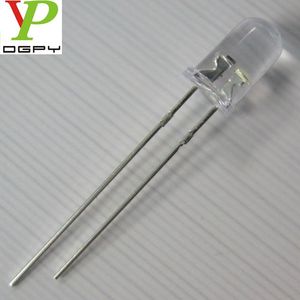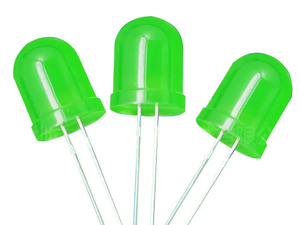(1589 products available)












































































































































































3V LED flashing lights are small lighting devices that emit light at a voltage of 3 volts. They are commonly used for decorative purposes in electronics and can be found in different types. Here are some of them:
Flashing Red LED
These LEDs are known for their brightness and are commonly used in applications that require high visibility. They are also preferred for their low power consumption, making them suitable for battery-powered devices. Flashing red LEDs are used in a wide range of products, for example, alarm systems, indicators, and various electronic projects.
Flashing Blue LED
These are blue lights that alternate between on and off states. They are commonly used in electronics due to their eye-catching appearance. Flashing blue LEDs are used in applications such as decorative lighting, vehicle lighting, and status indicators in electronic devices.
Flashing Green LED
These are green lights that repeatedly blink on and off. They are known for their brightness and low power consumption. Flashing green LEDs are widely used in electronic applications, including indicator lights, decorative lighting, and various electronic devices.
Flashing White LED
These are LEDs that alternate between on and off states. They are characterized by their brightness and efficiency. Flashing white LEDs are commonly used in applications such as automotive lighting, display backlighting, and decorative lighting.
Flashing RGB LED
RGB LEDs are capable of producing multiple colors by combining red, green, and blue light. The flashing effect can be achieved by lighting different colors in sequence or by rapidly changing the colors.
Flashing SMD LED
These are surface-mounted device LEDs that can flash at specific intervals. They are commonly used in circuit boards where space is limited. SMD LEDs are known for their small size and are used in smartphones, tablets, and other compact electronics.
Flashing High Power LED
These are LEDs that can produce a high amount of light output. They are commonly used for applications where brightness is needed. Flashing high-power LEDs are used in outdoor lighting, automotive headlights, and large display panels.
Flashing Ultra Violet (UV) LED
These are LEDs that emit light in the ultraviolet spectrum. They are used for specific applications that require UV light. Flashing UV LEDs are commonly used in black lights, sterilization devices, and certain types of visual effects.
Low Voltage Operation:
A key feature of 3V LED flashlights is their low voltage operation. This allows the use of batteries with low voltage, making them more energy-efficient. Low voltage operation reduces power consumption and extends battery life. It also makes these LEDs safer to use and environmentally friendly.
Flashing or Blinking:
These LEDs can flash or blink. This feature is important as it increases visibility and attracts attention. The blinking lights can be used for signaling or decorations. The flashing lights also conserve battery power by alternating between on and off.
Multiple Colors:
3V LED flashlights come in different colors. The multiple colors make them visually appealing and versatile for various uses. The lights are used as decorative lights for different events and holidays. The colors also have different uses in signaling and indicators.
Multiple Configurations:
They have different configurations. This feature makes the lights versatile for various applications. The multiple configurations allow the LEDs to be connected in series or parallel. It also makes them suitable for different voltage requirements.
High Brightness:
These LEDs have a high brightness output. The high brightness increases the visibility of the lights. This makes them suitable for use in well-lit and dark environments. The bright lights can be used for decorative purposes, lighting indicators and signals.
Compact Size:
The compact size of the 3V LED makes them convenient and space-saving. The small size allows them to be used in applications where space is limited. The compact size also reduces the weight of the device, improving portability.
Long Lifespan:
These LEDs have a long lifespan. This feature makes them cost-effective and reliable. The long lifespan reduces the frequency of replacements. This not only saves time but also lowers maintenance costs. The extended lifespan ensures the LEDs consistently produce light.
3V LED flashing lights have a wide range of applications across different industries and sectors. Here are some common usage scenarios:
Electronics Projects
Flashing LED lights are often used in DIY electronics projects. They serve as visual indicators to show that a circuit is working properly. Also, these LEDs can be connected to microcontrollers. When they are connected to microcontrollers, they can be used to indicate different statuses.
Consumer Products
Flashing LED lights are integrated into several consumer products. For instance, in electronic devices like remote controls, keyboards, and mice. They provide visual feedback to users. Also, they are used in alarm systems to indicate security status.
Toys and Novelties
Flashing LED lights are commonly used in toys, gadgets, and other novelty items. They make the products visually appealing and attractive to users. They also indicate when batteries are running low.
Clothing and Accessories
LED flashing lights are used in accessories like hats, bags, and jewelry. They enhance visibility when one is in a dimly lit environment. Also, they can be integrated into costumes for parties and events.
Safety and Emergency Lighting
Flashing LED lights are used in safety applications. For example, in construction sites, bicycles, and vehicles to enhance visibility and alert others. They are also used in traffic signals and emergency vehicles.
Decorative Lighting
LEDs come in different colors. When they are combined, they create visually appealing lighting effects. Flashing LED lights are used in party lights, Christmas lights, and other decorative displays. They are also used for accent lighting and event decorations.
Backlighting and Indicator Lights
These LED lights can be used as backlighting for devices like LCD screens. They provide a flashing indicator light for buttons and switches. Additionally, they can be used as status indicators in appliances and electronics.
Art Installations and Hobbies
Flashing LEDs are used in artistic installations to create dynamic and interactive displays. They are also used by hobbyists in projects like model railroads and illuminated signs.
When choosing LED flashlights, buyers should consider various factors to ensure they will meet their specific needs. Here are some of them.
Voltage compatibility
Buyers must ensure that the LED is compatible with the voltage levels of their circuitry. An LED with a voltage higher than that of the circuit may damage it, while one with a lower voltage may not function optimally.
Power consumption
Buyers should consider getting LED flashing lights with low power consumption. Such options will be more economical and will also have a lower negative impact on the environment.
Size and shape
The size and shape of the LED light will affect its intended use and the available space for its installation. Buyers should get LED lights in sizes and shapes suitable for their intended use or application and that will fit in the available space.
Brightness and color
Flash LED lights come in different colors, and their brightness also varies. Buyers should get colors that will be more visible in the intended environment or that will meet their requirements. They should also get options with brightness levels that are suitable for their intended use.
Quality and reliability
The quality of the LED light will determine its performance and lifespan. Buyers should choose quality lights from reputable manufacturers, even though they may be more expensive.
Heat dissipation
Although LED lights generate less heat than other types of lights, the heat produced can still have a negative effect on the performance of the light. Therefore, buyers should choose lights with efficient heat dissipation mechanisms.
Q1: How to connect a 3V LED to a power source?
A1: An LED can be connected to a battery or power source using a resistor to prevent excessive current flow. The resistor is calculated based on the LED's forward voltage and current rating.
Q2: Can someone use multiple 3V LEDS together?
A2: Yes, it is possible to connect multiple LEDs in series or parallel configurations. For series connections, use a higher voltage source and calculate the resistor for the total forward voltage. For parallel connections, use the voltage source equal to the forward voltage of one LED and calculate the resistor for each LED.
Q3: What makes the 3v LED flashing not work?
A3: Several factors can cause the LED not to work, such as incorrect resistor value, reverse polarity connection, or exceeding the forward current rating. It can also be a case of an open circuit or a faulty LED.
Q4: What is the lifespan of a 3V LED?
A4: The lifespan of an LED varies depending on the usage and operating conditions. Generally, it can last for several thousand hours, ranging from 30,000 to 50,000 hours.
Q5: What are the advantages of 3V LEDS?
A5: LEDS have several advantages, including lower power consumption and higher efficiency. They provide a longer lifespan and durability. In addition, they emit less heat and offer versatile lighting options.